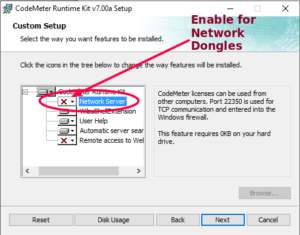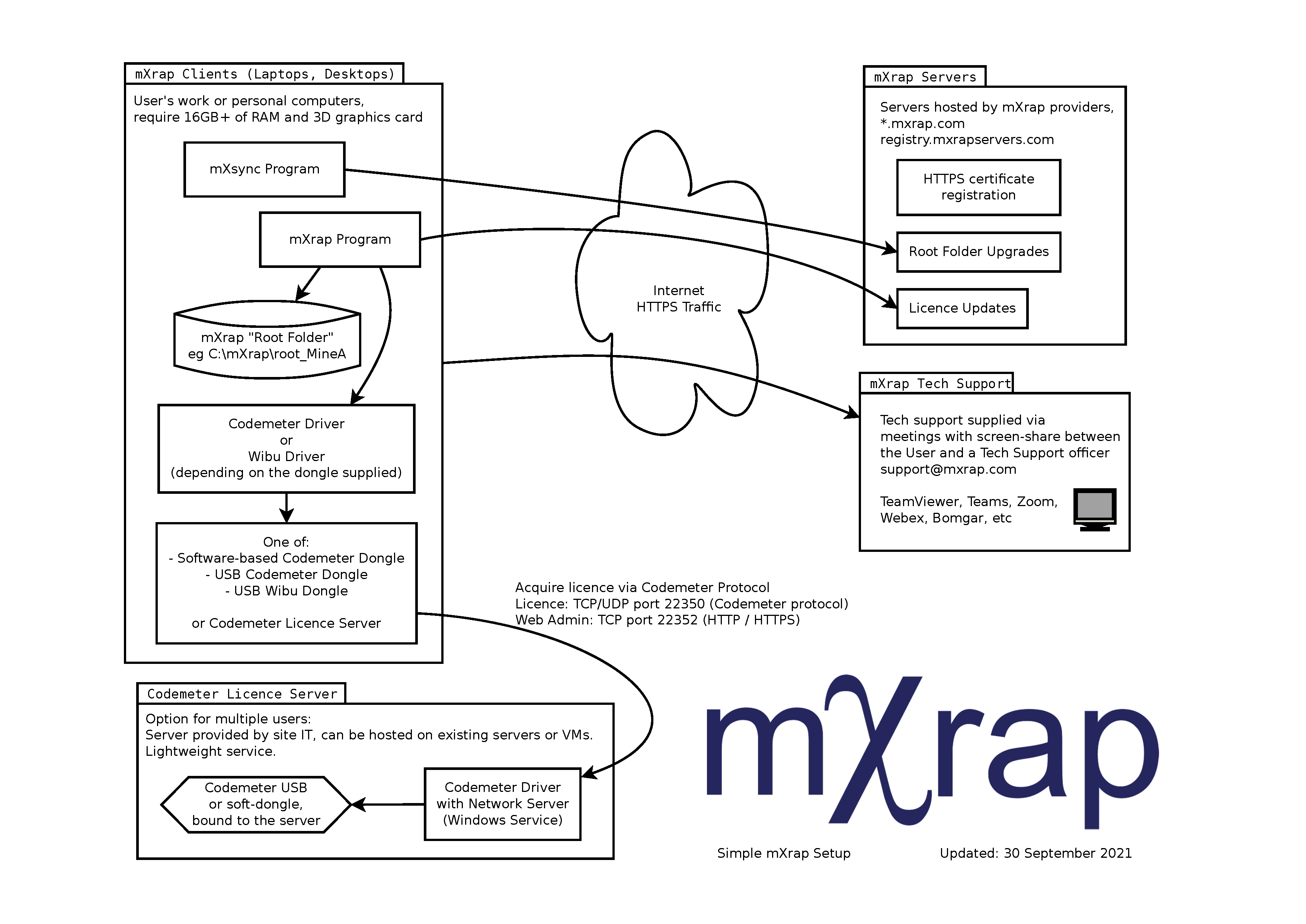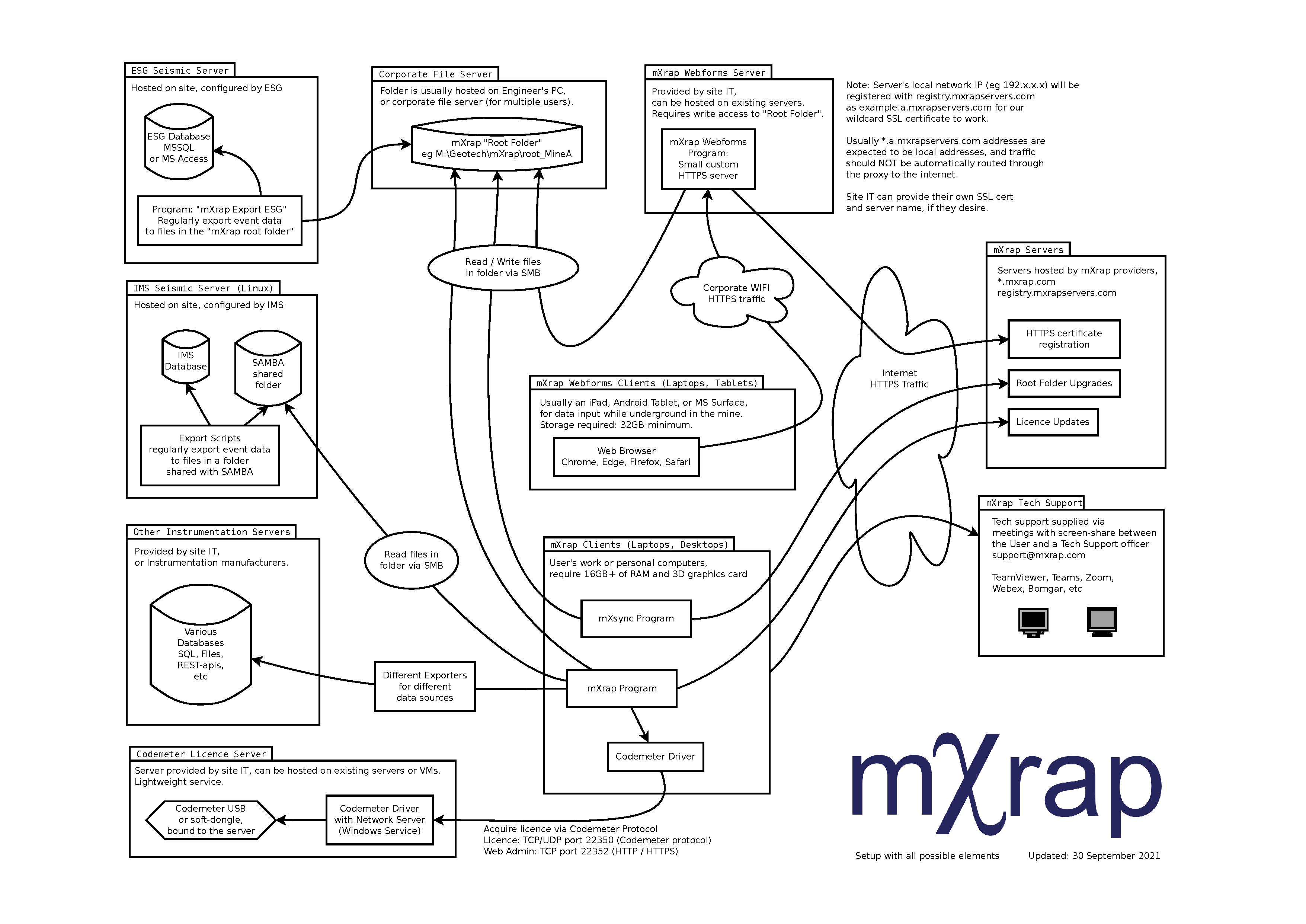IT personnel's guide to installing and managing mXrap
Deployment diagram
Note that your setup may not include some of the servers in this diagram.
- Consultants and Researchers will not have Seismic or Instrumentation servers.
- The CodeMeter Licence Server is not required for Wibu users.
- The CodeMeter Licence Server is not required if a physical CodeMeter dongle is plugged into the user’s computer directly.
- Webforms servers and clients are only required for sites using the Damage Mapping system.
- A Corporate File Server is not required if the user stores the data locally on their computer.
Hardware requirements
The minimum recommended requirements are:
- Graphics card that supports OpenGL 4.0 or higher, with updated graphics drivers.
- Note 1: We do not recommend Intel graphics cards as we have observed rendering and performance problems in the past.
- Note 2: We have experienced problems with computers with ‘switchable graphics’, but this seems to be functioning correctly after updating graphics drivers.
- Windows 7 or 10, 64-bit operating system.
- 8 GB of RAM (for sites with small data requirements).
- 16 GB of RAM (for sites with larger amounts of data).
Support requirements
We are asking (within reason) that IT allow us to connect to engineer’s computers via Teamviewer for support purposes. Remote access is only needed ‘on demand’, which means we have no access unless the engineer explicitly gives us access. You can use the ‘Quick Support’ version, which only allows connections while it is running and the engineer is there. This software is not installed on the machine (get it here). All but one of the consortium member companies allow Teamviewer OR some alternative, i.e. through VPN.
Please note that RDP is not an alternative as the engineer is not able to see the screen. It is therefore not useful for training and does not facilitate troubleshooting where the engineer’s input is required.
Client PCs
All PCs that run mXrap need the following:
- Updated graphics drivers.
- Security (USB-key) dongle drivers installed:
- If you have the Green Wibu Key, install the Wibu driver (with network options disabled – it’s an option during installation).
- If you have the Silver CodeMeter Key or Software-based dongle, install the CodeMeter driver.
- For information on where to get the drivers go here.
- See below for more information on CodeMeter setup.
- Access to the ‘root folder’, where the mXrap data is stored. This is usually either:
- On a local disk drive (for single-user sites).
- On a corporate network folder (for single and multi-user sites).
- On a shared folder on another engineer’s computer (for multi-user sites).
- On a shared folder on the ESG server (where the ESG server cannot access the corporate network).
- Access to the data sources to enable data updating:
- IMS Seismic data:
Read access to the IMS network drive, where .msrap_evp files are shared, IMS will set up a scheduled export to a read only shared folder. - ESG Seismic data:
ESG data is exported directly to the ‘root folder’, so both the engineer and the ESG server will require access to the ‘root folder’ location.
- IMS Seismic data:
- Install the latest version of mXrap software from here
- Choose the appropriate mXrap variant (choose CodeMeter or Wibu, and 64 or 32 bit).
- By default, it will install ‘per-user’, i.e. into AppData, but you can instruct it to perform a per-machine installation.
- Since it is an MSI installation, a group policy push for installing can be done.
- Note: if you really want to install for All Users, then you can do it with the command line (requires Admin rights):
msiexec /i mXrap_install_file.msi ALLUSERS=1
- The user should have read/write privileges to the PC. This is needed to save data from the software to the hard drive.
- Licence server (CodeMeter in network-mode only)
Depending on the agreement with the mXrap Consortium, a network licence may be set up. The licence server will broadcast messages to all other computers on the same subnet. If some computers are on a different subnet (or connected via VPN), each client computer can be configured to seek out the licence at a particular IP/hostname.
Licence server requirements
- The licence server can be any machine that is accessible by mXrap user PCs through the network.
- The CodeMeter driver needs to be installed and configured to act as a Network Server.
- If you are using a physical dongle the CodeMeter key must be plugged into the server.
- The CodeMeter server can be a virtual server. The USB dongle can be accessed by the server via products such as AnywhereUSB.
- Note that ONLY the one server should access the dongle via AnywhereUSB. Do NOT set up the system so the clients access the dongle via AnywhereUSB.
The CodeMeter dongle is not designed to operate that way, and we have seen problems when used like this. - If you are using a Software-based dongle it will need to be installed on the license server.
- Note, once the Software-based dongle has been installed on a device it can not be transferred.
Licence server setup
- Install CodeMeter drivers.

- Configure the CodeMeter as a network key, as follows:
- Open the ‘CodeMeter Control’ program and press the ‘WebAdmin’ button
- In the displayed webpage, browse to: Configuration –> Server
- Turn on the ‘Network Server’ and hit Apply
Licence client setup
- Install the dongle drivers (see above).
- For the silver CodeMeter or Software-based dongle:
- If it is used as a ‘network key’ then it should just work when the computer is connected directly to the office network.
- If the computer is used off-site and needs to connect to the office network key (via VPN), then:
- Open the ‘CodeMeter Control’ program and press the ‘WebAdmin’ button.
- In the displayed webpage, browse to:
Configuration –> Basic –> Server Search List. - Click Add and enter the IP or hostname.
- Hit Apply.
Data server
There are no services for data. All data is stored in one folder on any network drive. The location on the network drive is generally detemined by the engineers.
Post-installation setup
Once the drivers and mXrap are done, we can assist further with remote access through Teamviewer. These last post-installation configurations are limited to gathering and restructuring data, and a quick audit of the system.


